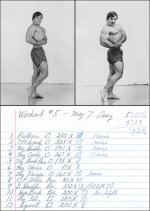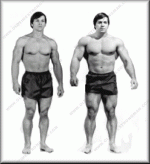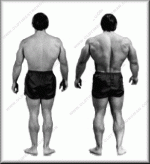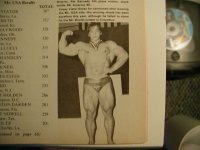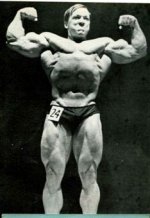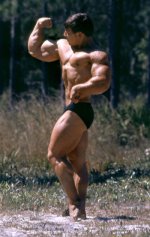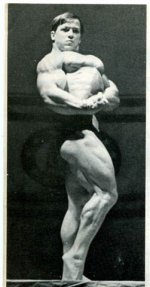alfresco
Featured Member / Kilo Klub Member
Staff member
Super Moderators
Moderator
Featured Member
Kilo Klub Member
Registered
Board Supporter
- Joined
- Jul 29, 2006
- Messages
- 6,388
Another post on this forum about an individuals ability to lose and gain
weight was questioned by some. But in reality, the ability to do this is
really not that unusual. The human body is an amazing organism, if
you just give it a chance. Bodybuilders (and other athletes) have been
manipulating their bodyweight to extremes for as long as there has been
exercise and they will continue to do so long after I am six feet under.
While not everybody can do this as successfully as they would like, part
of the problem in my opinion, is that many people "take" so many different
unverifiable things, at so many times, don't keep accurate records, that
they literally have no idea of the cause and effect between everything and
haven't the slightest knowledge of how little or how much of anything is
required to achieve a desired condition.
I'm showing my age here again but the example I'm about to give is the
best, verifiable case that I am aware of that will help illustrate my point.
And while controversial to some, to bodybuilders in general, they were
not that impressed and have openly said that it just an example of "muscle
memory." Which is obviously true. And if you don't think so . . . just try
duplicating these results with a previously untrained individual. Lot's of luck
is all I can say.
Many of the bodybuilders here are well aware of what follows, but for
those you who are not familiar with this, and for those still doubt the
ability of somebody with superior genetics to gain a large amount of
muscular tissue in a short amount of time; over 30 years ago, a very
successful experiment (if you can truly call it an experiment as the
sponsor had a pretty good idea what the results would be) was conducted
at the Department of Physical Education, Colorado State University, in
Fort Collins, Colorado under the supervision of a Dr. Elliott Plese (now
deceased), the then Director of Exercise Physiology Lab.
The subject pictured here is Casey Viator, a previous Mr. America winner.
In this experiment, he increased his bodyweight by ~45 pounds, lost ~17
pounds of body fat, for a total muscular gain in excess of 60 pounds
in 28 days. In retrospect, the sponsor of this study suspects that the total
muscular gain is slightly exaggerated due to the accuracy of the device
used to measure body fat, but the increase in bodyweight is not disputed.
I'll let the photos speak for themselves.
What the subject was experiencing was a clear case of muscle memory
as he was rebuilding previously existing muscle mass, and by his own
admission, aided by an abnormally, artificially low bodyweight. That it's
easier to gain muscular mass the second time around should be no secret
to anybody.
All this was achieved with a total of 14 total body workouts, performed on
a combination of new, prototype machines and with the use of free weights,
using primarily negative only resistance, with an average of 12 total sets per
workout. Not everybody can make these spectacular gains in such a brief
amount of time with such a limited amount of exercise. Attached is a copy of
the 5th workout this subject performed.
(photographs of the Casey Viator, copyright Inge Cook)
(scan of the workout number 5, courtesy of the author)
weight was questioned by some. But in reality, the ability to do this is
really not that unusual. The human body is an amazing organism, if
you just give it a chance. Bodybuilders (and other athletes) have been
manipulating their bodyweight to extremes for as long as there has been
exercise and they will continue to do so long after I am six feet under.
While not everybody can do this as successfully as they would like, part
of the problem in my opinion, is that many people "take" so many different
unverifiable things, at so many times, don't keep accurate records, that
they literally have no idea of the cause and effect between everything and
haven't the slightest knowledge of how little or how much of anything is
required to achieve a desired condition.
I'm showing my age here again but the example I'm about to give is the
best, verifiable case that I am aware of that will help illustrate my point.
And while controversial to some, to bodybuilders in general, they were
not that impressed and have openly said that it just an example of "muscle
memory." Which is obviously true. And if you don't think so . . . just try
duplicating these results with a previously untrained individual. Lot's of luck
is all I can say.
Many of the bodybuilders here are well aware of what follows, but for
those you who are not familiar with this, and for those still doubt the
ability of somebody with superior genetics to gain a large amount of
muscular tissue in a short amount of time; over 30 years ago, a very
successful experiment (if you can truly call it an experiment as the
sponsor had a pretty good idea what the results would be) was conducted
at the Department of Physical Education, Colorado State University, in
Fort Collins, Colorado under the supervision of a Dr. Elliott Plese (now
deceased), the then Director of Exercise Physiology Lab.
The subject pictured here is Casey Viator, a previous Mr. America winner.
In this experiment, he increased his bodyweight by ~45 pounds, lost ~17
pounds of body fat, for a total muscular gain in excess of 60 pounds
in 28 days. In retrospect, the sponsor of this study suspects that the total
muscular gain is slightly exaggerated due to the accuracy of the device
used to measure body fat, but the increase in bodyweight is not disputed.
I'll let the photos speak for themselves.
What the subject was experiencing was a clear case of muscle memory
as he was rebuilding previously existing muscle mass, and by his own
admission, aided by an abnormally, artificially low bodyweight. That it's
easier to gain muscular mass the second time around should be no secret
to anybody.
All this was achieved with a total of 14 total body workouts, performed on
a combination of new, prototype machines and with the use of free weights,
using primarily negative only resistance, with an average of 12 total sets per
workout. Not everybody can make these spectacular gains in such a brief
amount of time with such a limited amount of exercise. Attached is a copy of
the 5th workout this subject performed.
(photographs of the Casey Viator, copyright Inge Cook)
(scan of the workout number 5, courtesy of the author)



























































